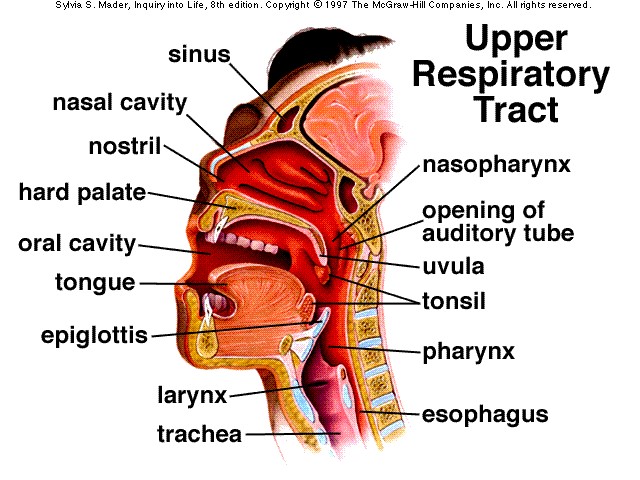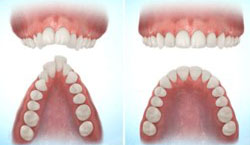“Every Breath You Take, Every Move You Make.”

By Laurie Gribschaw, DPT, ATC, PRC
Breathing: one of the basic things we take for granted since it happens as an automatic process. But how we breathe matters to our immune system, nervous system and dental health, especially for our developing children.
Let’s have a brief anatomy review to assess how nasal breathing helps our immune system and also decreases our risk of upper respiratory infections. Notice the position of the nasal passage above the mouth and tonsils. Air passing through the nasal cavity first is prepared with warming and moistening the air to prepare for delivery into the lungs. In addition to providing this first line of defense against incoming germs, the nasal passage also produces specific enzymes that lead to the development of nitric oxide (NO), an important gas that is critically important to regulating oxygen delivery around the body by having an effect on blood flow. Furthermore, NO has other actions within your internal gut microbiome to affect immune response and mitochondrial function, operating as a behind-the-scenes ally to keep us in a nice balanced state of homeostasis.
Unfortunately for us, mouth breathing provides us with zero contribution of nitric oxide, and gives those pesky unwanted microbes a nesting area right on our tonsils, or a direct route straight into our lungs for a pleasant upper respiratory infection (if your immune system can’t fight it off first). Physiologically, mouth breathing serves as a ‘fight or flight’ system response, a basic function to keep us alive or accommodate to some stressful experiences (as a weight lifter- a timed 1 mile run brings on mouth breathing for me!).
So what about dental health and the development of our jaw/facial structures? Nasal breathing is extremely important for proper growth of the palate in our children, which provides room for the teeth to fill in the mouth without over-crowding (let’s save you money on braces and palatal expanders!!). When nasal breathing, the proper position of the tongue resides on the hard (top) palate behind the front teeth which applies some direct pressure to further assist in expanding/growing the palate while allowing the airways to stay open by sealing the mouth cavity closed. This demonstrates a wonderful positive feedback mechanism where proper tongue position and nasal breathing contributes to proper development of the jaw/orofacial complex. This actively contributes to reduction of impacted teeth, high palates (cramped nasal sinuses) and mouth breathing leading down a stairway of snoring and sleep apnea. Here’s an example of a narrow/high palate vs a wide/normal palate that would promote optimal growth of the jaw and facial structures with supported nasal breathing:

Image Credit: Dental Chatswood http://sodental.com.au/airway-dentistry/nasal-breathing-vs-mouth-breathing/
Think nutrition might have something to do with proper jaw/dental development? You bet! Chewing nutrient dense foods in their natural state (a.k.a. non processed foods) promotes jaw development, and the longer kids chew, the longer their mouths stay closed to perform nasal breathing!
If you notice a tendency towards mouth breathing, there are a few easy things to check first:
- Can you breathe easily through each nostril? If not, then try using a sinus cleansing system like the Netti pot with distilled water, a nose strip to expand the airway, or address those allergies that can lead to congestion. Persistent blockage may need some investigation into food sensitivities or a doctor specializing in ENT (ears/nose/throat) to inspect the sinus cavities and lead a treatment plan.
- Note the resting place of your tongue; it should be placed behind the front teeth on the roof of the mouth; teeth should not be touching and lips should be closed. Sometimes this simple switch of practicing mindfulness intermittently throughout the day can promote nasal breathing!
- There are great ways to incorporate proper development for children; kazoos (or other instruments) work well with coaching the child to blow out through the kazoo and inhale through the nose. Also, a practitioner well aware of cranio-facial concepts can provide tongue exercises or other specifics to assist in normal development.
If some glaring difficulties with nasal breathing are discovered, don’t hesitate to get an evaluation and restore optimal breathing! As with many things in life, a little bit of prevention can promote significant efficiencies in the system that will enable optimal functioning over the long term. Often, a team approach works well as the head/face complex can benefit from different disciplines; Stride PTs can point you in the right direction!
Stay tuned for more integrative, holistic concepts that tie our beautiful system together and respect the body for the amazing system it is!
For our visual learners and those of us that like to nerd out on physiology, see it in action here at this amazing video that details the implications of nasal breathing vs mouth breathing:
https://www.youtube.com/mouthbreathing
References:
- Lin, Steven DDS. The Dental Diet (2018). https://www.drstevenlin.com/
- Cervical Revolution: An Integrated Approach to the Treatment of Patterned Cervical Pathomechanics. Postural Restoration Institute (2015).
- Video courtesy of YouTube: Dr. German Ramirez of TMJ & Sleep Therapy Centre of Northern Indiana
